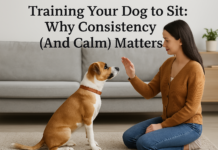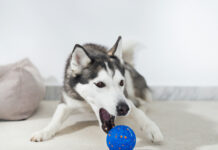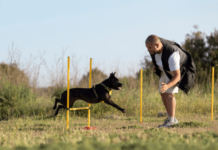Last Updated on July 21, 2024 by Dogs Vets
Training a pointing dog can be a rewarding experience, but it requires patience, consistency, and the right techniques.
Whether you’re a seasoned trainer or new to the game, teaching your dog to “whoa” is crucial for hunting success. Here’s a comprehensive guide to effectively train your pointing dog to master this essential command.
Understanding the “Whoa” Command
The “whoa” command instructs your dog to stop and stand still, a vital behavior during hunting. A dog that responds reliably to “whoa” will hold its position, allowing you to approach and flush the bird. This command is not just about obedience; it’s about ensuring a smooth and successful hunt.
Start with the Basics
- Leash Training: Begin training in a controlled environment using a leash and collar. Walk your dog at your side, then gently pull the leash upward while giving the “whoa” command. Praise and reward your dog for stopping.
- Repetition and Consistency: Practice this daily. Consistency is key in reinforcing the behavior. Gradually increase the time your dog stays in the “whoa” position before giving a release command.
Pointing dog lovers sound off!!! If you had to pick just one pointing dog breed, which one would it be and why?
Bird Dogs for Habitat runs now through the end of April, with prizes for voting and chances to win our weekly giveaway. The best part is, all funds generated from the… pic.twitter.com/JB8eAnUWmc
— Quail Forever (@quail4ever) April 12, 2023
Transition to Hands-Free
Once your dog reliably responds to the command on a leash, it’s time to transition to hands-free training.
- Check Cord Training: Attach a check cord to your dog’s collar and let them roam within a confined area. Command “whoa” and step on the cord if they move, reinforcing the stop command.
- Positive Reinforcement: Always use positive reinforcement. Reward your dog with treats or praise whenever they successfully follow the “whoa” command.
–
Our Dog of the Day is this cute German Shorthaired Pointing Dog 😍The German Shorthaired Pointing Dog is the place 11 of the most popular dog breeds worldwide 🐶#Dog #dogs #puppy #dogsoftwitter pic.twitter.com/lEK1vZrZhn
— Clever Crypto Dogs #❤️❤️❤️ (@CleverCryptoDog) October 28, 2021
Introducing Distractions
Hunting environments are full of distractions. Training your dog to maintain the “whoa” command amidst these distractions is crucial.
- Controlled Distractions: Start with minor distractions, such as other dogs or noises. Gradually increase the level of distractions as your dog improves.
- Field Training: Transition to outdoor settings where birds are present. Use the check cord to reinforce the “whoa” command when your dog gets excited by birds.
Advanced Techniques
For advanced training, consider these methods to fine-tune your dog’s “whoa” command.
- E-Collar Training: If used correctly, an electronic collar can be an effective tool. Introduce the collar slowly, associating the “whoa” command with the collar’s stimulation.
- Professional Training: If you encounter difficulties, seeking help from a professional trainer can be beneficial. They can provide advanced techniques and personalized advice for your dog.
Common Challenges and Solutions
Training doesn’t always go smoothly. Here are common challenges and how to address them:
- Stubbornness: Some dogs may resist the command. Use high-value rewards and ensure you’re not pushing too quickly.
- Inconsistent Response: If your dog is inconsistent, return to basics and reinforce the command in a controlled environment.
- Distraction Overload: If your dog gets too distracted, reduce the level of distractions and gradually reintroduce them.
The Importance of Patience and Consistency
Training a pointing dog to respond reliably to the “whoa” command takes time and patience. Consistency in your commands, rewards, and practice sessions is crucial. Celebrate small victories and progress, as these will lead to a well-trained hunting companion.
Conclusion
Training your pointing dog to “whoa” is an essential skill for successful hunting. By starting with the basics, using positive reinforcement, and gradually introducing distractions, you can train your dog to be a reliable hunting partner. Remember, patience and consistency are key. Happy hunting!
FAQs
1. What age should I start training my pointing dog to “whoa”?
Training can begin as early as 6 months old, but it’s essential to consider your dog’s maturity and attention span.
2. How long does it typically take to train a dog to “whoa”?
The timeline varies, but with consistent daily training, most dogs learn within a few months.
3. Can older dogs learn the “whoa” command?
Yes, older dogs can learn, though it may take more patience and time compared to younger dogs.
4. What if my dog refuses to “whoa”?
Return to basics, use high-value rewards, and ensure the training environment is controlled and free of distractions.
5. Should I use an e-collar for “whoa” training?
E-collars can be effective if used correctly. It’s recommended to seek guidance from a professional trainer to avoid misuse.
Fact Check
We strive to provide the latest valuable information for pet lovers with accuracy and fairness. If you would like to add to this post or advertise with us, don’t hesitate reach us. If you see something that doesn’t look right, contact us!

















